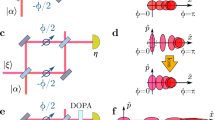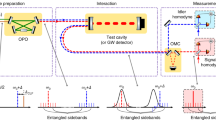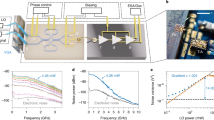Abstract
We have implemented non-Gaussian operation in pulsed squeezed vacuum at a telecommunications wavelength. A one- or two-photon-subtracted squeezed state was generated using a titanium superconducting transition-edge sensor to resolve the incident photon number. We observed dips in the reconstructed Wigner functions of the generated quantum states, which provides clear evidence that non-Gaussian operation has been realized.
This is a preview of subscription content, access via your institution
Access options
Subscribe to this journal
Receive 12 print issues and online access
$209.00 per year
only $17.42 per issue
Buy this article
- Purchase on Springer Link
- Instant access to full article PDF
Prices may be subject to local taxes which are calculated during checkout



Similar content being viewed by others
References
Shannon, C. E. A mathematical theory of communication. Bell System Tech. J. 27, 379–423 (Part I) and 623–656 (Part II) (1948).
Holevo, A. S. The capacity of quantum channel with general signal states. IEEE Trans. Inform. Theory 44, 269–273 (1998).
Schumacher, B. & Westmoreland, M. D. Sending classical information via noisy quantum channels. Phys. Rev. A 56, 131–138 (1997).
Giovannetti, V., Guha, S., Lloyd, S., Maccone, L., Shapiro, J. H. & Yuan, H. P. Classical capacity of the lossy bosonic channel: the exact solution. Phys. Rev. Lett. 92, 027902 (2004).
Fiuŕǎsek, J. Gaussian transformations and distillation of entangled Gaussian states. Phys. Rev. Lett. 89, 137904 (2002).
Eisert, J., Scheel, S. & Plenio, M. B. Distilling Gaussian states with Gaussian operations is impossible. Phys. Rev. Lett. 89, 137903 (2002).
Giedke, G. & Cirac, J. I. Characterization of Gaussian operations and distillation of Gaussian states. Phys. Rev. A 66, 032316 (2002).
Lloyd, S. & Braunstein, S. L. Quantum computation over continuous variables. Phys. Rev. Lett. 82, 1784–1787 (1999).
Gottesman, D., Kitaev, A. & Preskill, J. Encoding a qubit in an oscillator. Phys. Rev. A 64, 012310 (2001).
Wenger, J., Brouri, R. T. & Grangier, P. Non-Gaussian statistics from individual pulses of squeezed light. Phys. Rev. Lett. 92, 153601 (2004).
Ourjoumtsev, A., Brouri, R. T., Laurat, J. & Grangier, P. Generating optical Schrödinger kittens for quantum information processing Science 312, 83–86 (2006).
Neergaard-Nielsen, J. S., Nielsen, B. M., Hettich, C., Mølmer, K. & Polzik, E. S. Generation of a superposition of odd photon number states for quantum information networks. Phys. Rev. Lett. 97, 083604 (2006).
Wakui, K., Takahashi, H., Furusawa, A. & Sasaki, M. Photon subtracted squeezed states generated with periodically poled KTiOPO4 . Opt. Express 15, 3568–3574 (2007).
Miller, A. J., Nam, S. W., Martinis, J. M. & Sergienko, A. V. Demonstration of a low-noise near-infrared photon counter with multiphoton discrimination. Appl. Phys. Lett. 83, 793–795 (2003).
Fukuda, D. et al. High speed photon number resolving detector with titanium transition edge sensor. J. Low Temp. Phys. 151, 100–105 (2008).
Achilles, D. et al. Photon-number-resolving detection using time-multiplexing. J. Mod. Opt. 51, 1499–1515 (2004).
Fukuda, D. et al. Photon number resolving detection with high speed and high quantum efficiency. Metrologia 46, S288 (2009).
Kurimura, S., Kato, Y., Maruyama, M., Usui, Y. & Nakajima, H. Quasi-phase-matched adhered ridge waveguide in LiNbO3 . Appl. Phys. Lett. 89, 191123 (2006).
Anderson, M. E., Beck, M., Raymer, M. G. & Bierlein, J. D. Quadrature squeezing with ultrashort pulses in nonlinear-optical waveguides. Opt. Lett. 20, 620–622 (1995).
Eto, Y., Tajima, T., Zhang, Y. & Hirano, T. Observation of squeezed light at 1.535 µm using a pulsed homodyne detector. Opt. Lett. 32, 1698–1700 (2007).
Namekata, N., Makino, Y. & Inoue, S. Single-photon detector for long-distance fiber-optic quantum key distribution. Opt. Lett. 27, 954–956 (2002).
Hansen, H. et al. Ultrasensitive pulsed, balanced homodyne detector: application to time-domain quantum measurements. Opt. Lett. 26, 1714–1716 (2001).
Appel, J., Hoffman, D., Figueroa, E. & Lvovsky, A. I. Electronic noise in optical homodyne tomography. Phys. Rev. A 75, 035802 (2007).
Lvovsky A. I. Iterative maximum-likelihood reconstruction in quantum homodyne tomography. J. Opt. B 6, S556–S559 (2004).
Kenfack, A. & Życzkowski, K. Negativity of the Wigner function as an indicator of non-classicality. J. Opt. B 6, 396–404 (2004)
Eto, Y., Tajima, T., Zhang, Y. & Hirano, T. Observation of quadrature squeezing in a χ2 nonlinear waveguide using a temporally shaped local oscillator pulse. Opt. Express 16, 10650–16657 (2008).
Acknowledgements
The authors thank T. Itatani for providing support regarding TES device fabrication. This research was supported by National Institute of Information and Communication Technology (NICT).
Author information
Authors and Affiliations
Contributions
N.N. and Y.T. contributed equally as first authors. N.N. and Y.T. performed the experiments and analysed the data. G.F. and D.F. fabricated the photon-number-resolving detector based on the Ti-TES. S.K. fabricated the periodically poled lithium niobate adhered-ridge waveguide. S.I. supervised the project. N.N., Y.T. and S.I. contributed to writing the paper.
Corresponding author
Ethics declarations
Competing interests
The authors declare no competing financial interests.
Rights and permissions
About this article
Cite this article
Namekata, N., Takahashi, Y., Fujii, G. et al. Non-Gaussian operation based on photon subtraction using a photon-number-resolving detector at a telecommunications wavelength. Nature Photon 4, 655–660 (2010). https://doi.org/10.1038/nphoton.2010.158
Received:
Accepted:
Published:
Issue Date:
DOI: https://doi.org/10.1038/nphoton.2010.158
This article is cited by
-
Photon Number Resolution with an Iridium Optical Transition Edge Sensor at a Telecommunication Wavelength
Journal of Low Temperature Physics (2023)
-
Entangled states shaping with CV states of definite parity
Scientific Reports (2022)
-
Nonclassicality detection from few Fock-state probabilities
npj Quantum Information (2022)
-
Distribution and quantification of remotely generated Wigner negativity
npj Quantum Information (2022)
-
Nonclassicality and entanglement properties of non-Gaussian entangled states via a superposition of number-conserving operations
Quantum Information Processing (2020)



